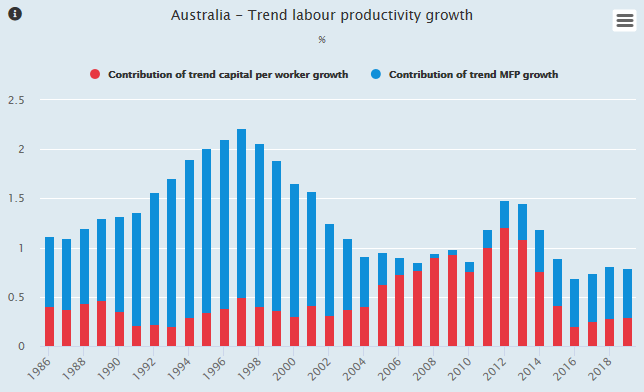Productivity Profile of Australia
 Organisations
Organisations
National level: the Productivity Commission, the Treasury and the Department of Industry, Science, Energy and Resources conduct analysis related to productivity issues;
State level (non-exhaustive): Independent Pricing and Regulatory Tribunal (New South Wales), New South Wales Productivity Commission, Queensland Productivity Commission, South Australian Productivity Commission;
Ad hoc task forces: numerous task forces have been commissioned on policy issues that have strong linkages to productivity (in addition to work commissioned through the Productivity Commission). One recent example is the ‘Harper Competition Review’ (2015).
 Selected Publications
Selected Publications
Productivity Commission: Productivity Inquiry Interim Reports (Periodical) Productivity Bulletins and Updates (Annual), Productivity Insights series (Periodical) Report on Government Services (Annual) Working from Home (2021), Growing the digital economy in Australia and New Zealand (2019);
Treasury: Reaching for the stars: Australian firms and the global productivity frontier (2022), Product marker power and its implications for the Australian economy (2021), Australian labour force participation: historical trends and future prospects (2021), Measuring productivity dispersion in selected Australian industries (2019), Productivity-enhancing labour reallocation in Australia (2019);
Department of Industry, Science, Energy and Resources: Do manufacturing entrepreneurs in Australia have (or develop) a productivity advantage? (2019)
Ad Hoc: Harper Competition Policy Review (2015);
OECD: Economic Surveys Australia (multiple), Preparing for the Future of Work Across Australia (2021), The COVID-19 shock and productivity-enhancing reallocation in Australia: Real-time evidence from Single Touch Payroll (2021), Indigenous Employment and Skills Strategies in Australia (2019), Financial Incentives to Promote Adult Learning in Australia (2019).
 Data
Data
Click here to access our Compare-Your-Country tool and explore productivity data from the GFP member countries.

 Latest OECD Recommendations
Latest OECD Recommendations
About one-fifth of Australian workers require a license to perform their work. Most need distinct licenses in each Australian state and territory. This unnecessarily raises economic costs, including by slowing resource reallocation.
- Legislate automatic mutual recognition of occupational licenses.
- Further investigate occupational licensing requirements from systemic and sectoral perspectives, considering the avenues for further harmonisation across jurisdictions and the extent to which new technologies are making existing licenses obsolete.
- Improve data collection about occupational licensing regimes across the country and information exchange systems between jurisdictions.
Land needs to be repurposed to take into account structural changes, not least those induced by the pandemic. However, there is limited incentive for local authorities in desirable locations to attract new businesses or expand dwelling supply.
- Allow local authorities to raise more of their own-source revenue, at the same time as reallocating the minimum Financial Assistance Grant from wealthier local authorities to those in more disadvantaged areas.
- Move towards fewer land zone types, which are harmonised where possible, and less prescriptive about the types of activities that can be undertaken.
There are signs of reduced competitive intensity in product markets. In particular, firm entry rates have declined in digitally intensive sectors. There has been a pick-up in merger and acquisition activity in the technology sector over the recent period.
- Consider the introduction of an unfair practices provision to eliminate various practices that are a clear abuse of market power but are currently not illegal.
- Consider changes to merger review legislation that better take into account the competitive dynamics in digital markets.
Related Documents


